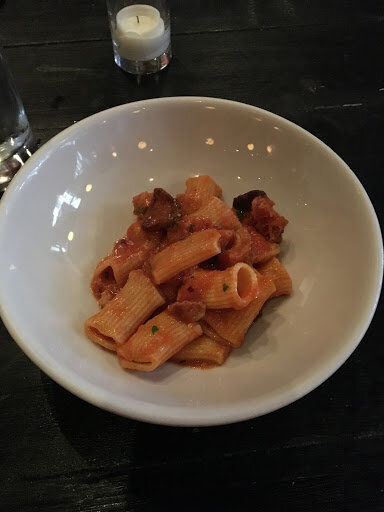Lupa Review
A well known, treasured, and bustling restaurant differentiates itself from the endless, equally bland walk-up apartment buildings on the quiet NoHo Thompson Street. Mario Batali opened Lupa in late 1999 as an osteria specializing in the cuisine of Rome. Since then, the destination has become recognized as one of Batali’s most respected restaurants. It has been described as “better-than-homey” by the New York Magazine. Lupa is known for its trippa alla romana (beef tripe in tomato sauce), and especially, its simple, rustic pasta, possibly some of the best in the city. Knowing this, there was luckily a pasta tasting option, which was ripe for the ordering, hence I could not pass it up, and this review emphasizes it.
The first course consisted of tonnarelli (similar to linguine) with cacio e pepe sauce, which simply consists of Pecorino Romano cheese and black pepper. Though very simple, the sauce was made very finely, using high quality cheese, and an adequately sizeable amount of pepper (required for this dish). The pasta was perfectly cooked, not too al dente, yet not too cooked. Also with the cacio e pepe, came the tripe. The tripe was cooked excellently, the texture was Soft, yet still with some chewiness.
For the second course, spaghetti alla carbonara, another Roman classic, was served. Carbonara sauce is a derivative of cacio e pepe; the key difference is the addition of egg. The egg helps emulsify the sauce, helping make a result that is thick, yet flowing. Finally, the guanciale (similar to pancetta), helped add a crispy and smoky addition. Combined with the smooth pasta, a decadent, yet flowing, and simple dish is synthesized.
For the third course, a saltimbocca ravioli was served. Saltimbocca is another classic from Rome, which is made from veal, prosciutto, and sage, rolled up, and cooked in white wine. Veal is known to have much less flavor than matured beef. However, this veal is close to beef, or even pork in flavor, with its fat content. Perhaps it was a very “mature” young cow. Though the flavor was good, the texture was not. Is was dry, almost like chewed up toast in a dry mouth. Furthermore, the veal was over salted, and just a little too much sage, slightly overpowering the veal. Despite the subpar filling, the pasta was nicely boiled like the others, just past al dente.
The next course was a dish called pajata finta. It consisted of rigatoni, guanciale (similar to bacon or pancetta), tomato sauce, and ricotta cheese. As usual, the pasta was boiled to a perfect texture (just past al dente). The guanciale was crispy, and chewy at the same time. Also, the guanciale helps add a smokiness to the creamy ricotta. The ricotta, though of high quality, and adding a creaminess to the dish, it was too much in quantity. It overwhelmed the sauce, making the overall dish slightly dry, and lacking in finesse.
The final pasta was bucatini all'amatriciana. It is simply bucatini (a hollow long pasta), with guanciale and amatriciana sauce (slightly spicy tomato sauce). This dish is a basic, smoky dish. The smokiness of the guanciale and the spice of the tomato sauce help create a low-key dish, like minimally smoked salmon.
Most of the pastas were excellent. However, because of a few flaws in two of the dishes, the overall food experience was not perfect. Was I fully satisfied? Not completely, given the legendary reputation of both the restaurant and the chef gave me high expectations, which were not fully met. I guess Lupa is mortal, after all.
- Lucas Wang



